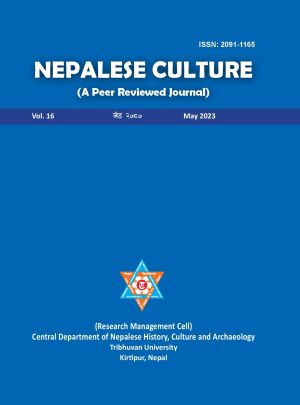लुँती अजिमा जात्रा र जीव आहुति होम {Lunti Ajima Jatra and Jiva Aahuti Homa}
DOI:
https://doi.org/10.3126/nc.v16i1.54125Keywords:
Luti Ajima, Jeva Aahuti Homa, Homa, FestivalAbstract
मध्यकालीन काठमाण्डौ सहरको पश्चिमतर्फ विष्णुमती नदी किनारको ढल्को टोलमा एक शक्तिपीठ रहेको छ जसलाई स्थानीय नेवार समुदायले लुँती अजिमा नामले सम्बोधन गर्ने गर्दछन् । पौराणिक कालकी अष्ठमातृका देवी मध्येकै एक इन्द्राणीको रूपमा पुजिने यी लुँती अजिमा काठमाण्डौको पुरानो बस्ती त्यौड टोल र ठँहिटि क्षेत्रका नेवार बस्तीको संरक्षक देवी हुन् । मध्यकालमा उनलाई उक्त टोलका बासिन्दाहरूले बस्तीको रक्षक देवी स्वीकार गरे र टोलकै अग्रज व्यक्तिका घरमा स्थापना गरी पूजाआजा गर्ने परम्परा चलाए । यी अजिमालाई हरेक वर्ष मसानघाट क्षेत्रको पीठमा लग्ने, विशेष तान्त्रिक पूजा र होम गर्ने तथा भोलिपल्ट जात्राका साथमा यी अजिमालाई टोलमै स्थापना गर्ने परम्परा रहेको छ । यसलाई लुँती अजिमा जात्रा वा इन्द्राणी जात्रा भनिन्छ । यस्तो महत्वपूर्ण जात्रा र होम अधिक सहरीकरण र नदीको जलप्रदूषणको कारणले र तान्त्रिक पूजा विधिको विश्मरणको कारणले लोप हुने अवस्थामा पुग्न लाग्दा पनि यस विषयमा गहिरो खोजको अभाव रहेको छ । लुँती अजिमा कस्तो प्रकारको मातृशक्ति हुन् ? यस अजिमा जात्राको अर्थ र प्रयोजन के हो ? र यस अवसरमा गरिने जीव आहुति होम कस्तो प्रकृतिको होम हो ? भन्ने मुख्य शोध प्रश्नहरूको उत्तर खोजीको उदेश्यले यो अध्ययन कार्य गरिएको हो । यसका लागि गुणात्मक प्रकृतिको अध्ययन विधि छनोट गरिएको छ । प्रत्यक्ष अवलोकनबाट, जात्रा र होमकार्यमा संलग्न सम्बन्धित व्यतिmसँगको अन्तवार्ताबाट र प्रकाशित पूर्व साहित्यहरूबाट तथ्यहरू संकलन गर्ने कार्य गरिएको छ । संकलित तथ्यहरूको सम्पादन, तिनको सत्यता परीक्षण र तथ्यहरूको समीक्षा एवं विश्लेषण गरेर निश्कर्षमा पुग्ने वर्णनात्मक विधिको अनुसरण गर्दै यो अध्ययन पूरा गरिएको छ । अध्ययनबाट यी अजिमा हिन्दुु धार्मिक साहित्यले वर्णन गरेको इन्द्राणी नै रहे तापनि भिन्न व्यक्तित्व भएको स्थानीय देवीको रूपमा स्थापित हुन पुगेको तथ्य प्रकाशमा आएको छ । यसै गरी उनको जात्रा शाक्त तान्त्रिक पूजा र जीव आहुति होम मार्फत् उनमा रक्षा शक्ति पुनः स्थापना गराउने धार्मिक उत्सवको रूपमा प्रचलनमा रही आएको तथ्य प्रकाशमा आएको छ । यस बाहेक जात्राको अवसरमा हुने जीव आहुति होम हिन्दु वैदिक होमभन्दा भिन्न तान्त्रिक शाक्त परम्पराको जीव आहुति होम रहेको तथ्य पनि यस अध्ययबाट प्रकाशमा आएको छ ।
{On the western side of the Kantipur city lies a temple of mother goddesses called Luti Ajima by the local Newar community. This mother goddess is one of the eight ancient mother goddesses known as Indrani. Luti Ajima. She is the protector goddess of the Newar community of Tyodah and Thahity. The goddess was accepted as the protector deity and her idol was housed at the senior member's house. Every year the goddess is taken to her temple at the river bank near the crematory ground, a special tantric puja, and homa is performed and the next day a chariot procession is performed called Luti Ajima Jatra or Indrani Jatra. Such an important Jatra is losing its charm because of urbanization and the decontamination of the river. Along with this the tantric puja and Homa performed during this Jatra are also on the verge of extinction. So, at this moment, intense research is much needed to answer some of the research questions. Like Who is Luti Ajima? What is the meaning and significance of the Jatra and What type of tantric Homa is performed at the premises of the temple? The present study has been carried out to find the answer to the above-mentioned questions. Qualitative research design has been selected. Direct observation and interview with persons involved in the Jatra and Homa along with the published materials on the same subject have been consulted. The study is completed after compiling and checking the facts and reaching the final conclusion using a qualitative method. The final outcome of the research is that Luti Ajima is the same mother goddess described by the Hindu scriptures as Indrani but here she is worshipped as a local deity. The Homa that is performed is done to revitalize the cosmic energy of the goddess. Along with this the Homa performed here with the animal sacrifice is a different one than the Vedic Homa and it reflects Tantric Shaktism}.
Downloads
Downloads
Published
How to Cite
Issue
Section
License
© Central Department of Nepalese History, Culture and Archaeology, Tribhuvan University




